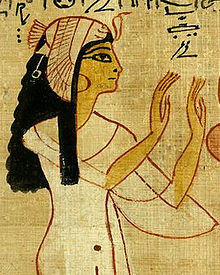Nodjmet
| Nodjmet | |
|---|---|
| Queen consortofEgypt | |
 Nodjmet depicted as a queen, from herBook of the Deadpapyrus. | |
| Died | c. 1064 BCE |
| Burial | Thebes, eventually inTT320 |
| Spouse | possiblyPiankh,thenHerihor |
| Issue | Pinedjem Iand others (see text) |
| Father | Ramesses XI? |
| Mother | Hrere |
Nodjmet,Nedjmet,orNotmitwas anancient Egyptiannoblewoman of the late20th-early21stdynasties of Egypt, mainly known for being the wife ofHigh Priest of AmunatThebes,Herihor.
Life
[edit]| Nodjmet inhieroglyphs | |||||
|---|---|---|---|---|---|
| Era:New Kingdom (1550–1069 BC) | |||||
Nodjmet may have been a daughter of the last ramessidepharaoh,Ramesses XI,and likely evenPiankh's wife, if the latter really was Herihor's predecessor as supported by Karl Jansen-Winkeln.[1]Early in her life, she held titles such asLady of the HouseandChief of theHaremof Amun.[2]
According to the two Egyptologists Aidan Dodson and Dyan Hilton,[3]Nodjmet had several children with her first husband Piankh: Heqanefer, Heqamaat, Ankhefenmut, Faienmut (a female) and, the most famous of all, the futureHigh Priest of Amun/PharaohPinedjem I.Nodjmet became Piankh's most trusted confidant, and every time he had to fulfill his business in Nubia, the management of Thebes was left to her. When around 1070 BCE Piankh died, Herihor was proposed as his successor; Nodjmet, however, managed to keep her prerogatives marrying this man.[4]Later, Herihor claimed “kingship” – although only inside the borders of theTemple of AmunatKarnak– Nodjmet effectively became his “queen”:her name was inscribed inside acartoucheand later she bore titles such asLady of theTwo LandsandKing's Mother.[2]

Nodjmet outlived even her second husband, and finally died in the first years of pharaohSmendes(c. 1064 BCE).[5]
Mummy
[edit]Hermummywas discovered in theDeir el-Baharicache (TT320). The body is that of an old woman. She had been embalmed with a new mummification technique which involved the use of fake eyes and the packing of the limbs and face. The heart was still in place inside her body.[6] With her mummy twoBooks of the Deadwere found.[7] One of them, Papyrus BM 10490, now in theBritish museum,belonged to “the King’s Mother Nodjmet, the daughter of the King’s MotherHrere”.Whereas the name of Nodjmet was written in a cartouche, the name of Hrere was not. Since mostly this Nodjmet is seen as the wife of the High Priest Herihor, Herere’s title is often interpreted as “King’s Mother-in-law”,[8]although her title “who bore the Strong Bull” suggests that she actually must have given birth to a king.[9]The other Book of the Dead from her tomb can also be found in the British Museum's collection (BM 10541) and is one of the most beautifully illustrated papyri from ancient Egypt.[10]
References
[edit]- ^Karl Jansen-Winkeln, “Das Ende des Neuen Reiches”,ZAS119 (1992), pp. 22-37.
- ^abKitchen, The Third Intermediate Period in Egypt (1100–650 BC), 1996, Aris & Phillips Limited, Warminster, 40-45.
- ^Aidan Dodson & Dyan Hilton,The Complete Royal Families of Ancient Egypt,Thames & Hudson, 2004,ISBN0-500-05128-3,pp. 200-201.
- ^John Taylor,Nodjmet, Payankh and Herihor: The end of the New Kingdom reconsidered,in Christopher J. Eyre (ed),Proceedings of the Seventh International Congress of Egyptologists,Leuven 1998, pp. 1143-55.
- ^Kitchen, o.c., 81, n.397.
- ^Margaret R. Bunson,Encyclopedia of Ancient Egypt, revised edition,2002, Facts on File, New York, pp. 279-80.
- ^Kitchen, o.c., 42-45
- ^Kitchen, o.c., 44
- ^Wente, JNES 26 (1967), 173-174
- ^British Museum Collection
Bibliography
[edit]- E. A. Wallis Budge,Facsimiles of the Papyri of Hunefer, Anhai, Kerasher and Netchemet,London 1899.
- Aidan Dodson & Dyan Hilton, The Complete Royal Families of Ancient Egypt, Thames & Hudson, 2004,ISBN0-500-05128-3,200-201.
- Karl Jansen-Winkeln,“Das Ende des Neuen Reiches”,ZAS119 (1992), 22-37.
- Kenneth Kitchen,The Third Intermediate Period in Egypt (1100–650 BC),1996, Aris & Phillips Limited, Warminster,ISBN0-85668-298-5.
- Ursula Rößler-Köhler,Piankh - Nedjemet - Anchefenmut - eine Kleinigkeit,GM 167 (1998), 7-8.
- John Taylor,Nodjmet, Payankh and Herihor: The end of the New Kingdom reconsidered,in Christopher J. Eyre (ed),Proceedings of the Seventh International Congress of Egyptologists,Leuven 1998, 1143-1155.
